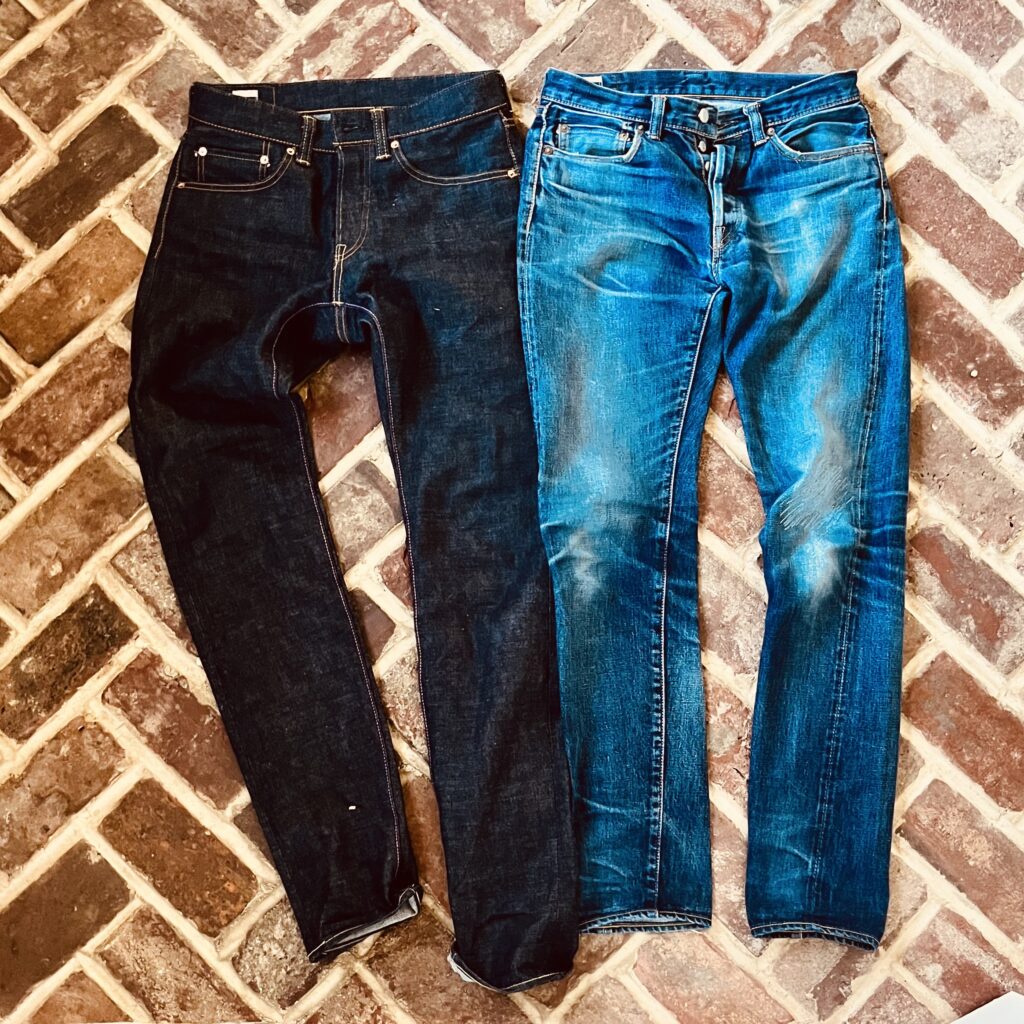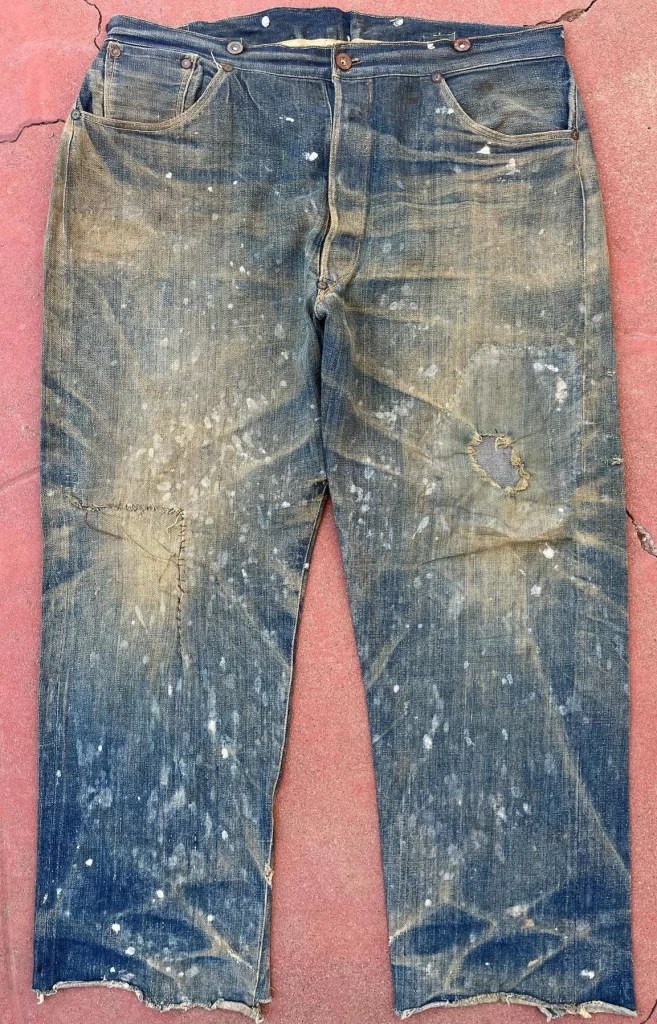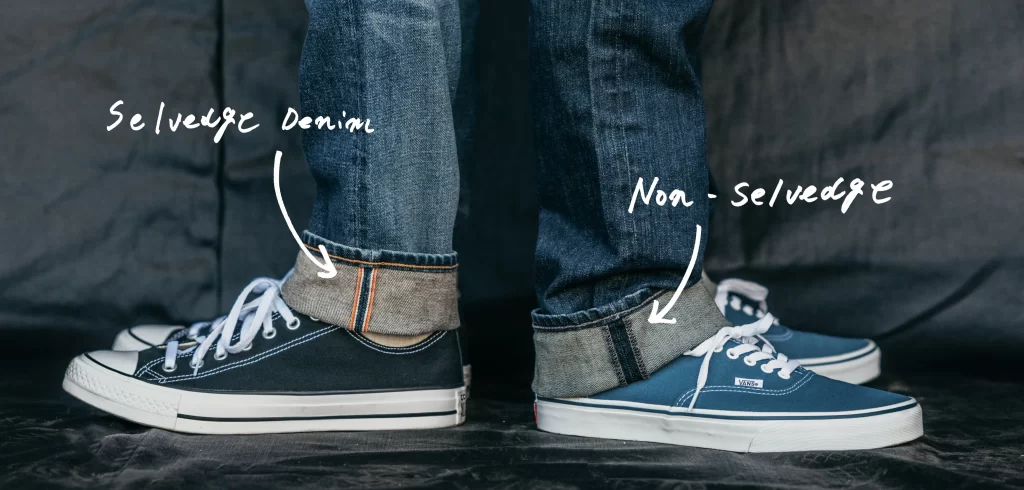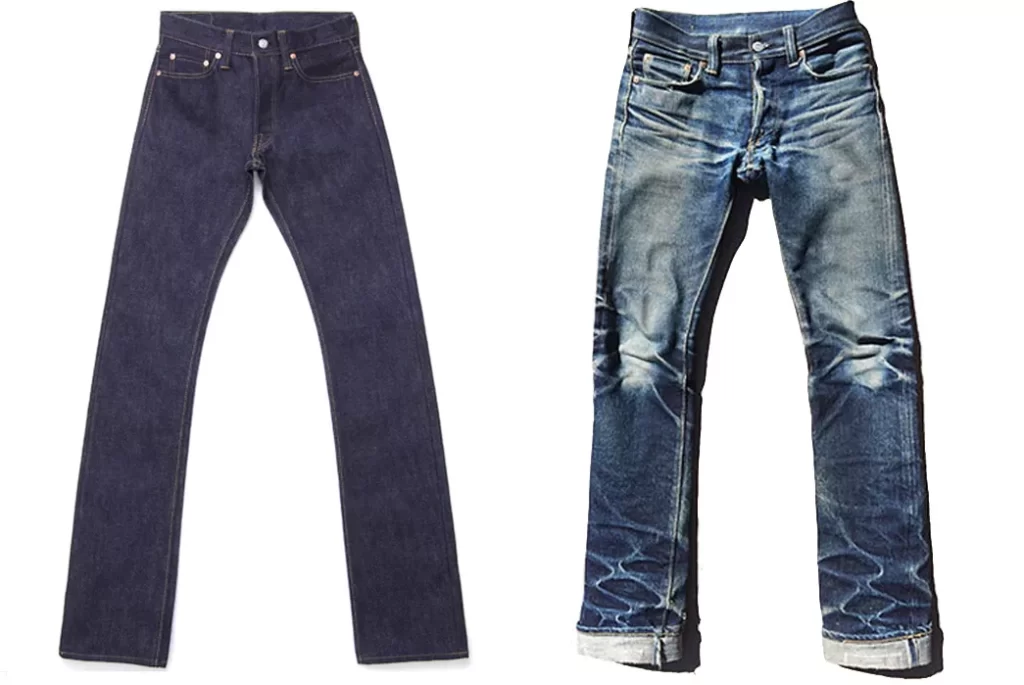–
Japanese Raw Denim
–
Raw Denim is a product and industry that defies textbook business. I won’t talk you into buying a pair – but you’d silly not to learn from this market evolution.
To receive these writings directly in your inbox. Subscribe here.
My first raw denim. Everyone remembers their first raw denim. I went over to the niche famous Blue in Green in SOHO, NYC. It was a weekend so I did my best to blend in – but at the time I was a clean-cut, suit-wearing, Goldman guy. After struggling with the door – I was quickly relieved it was not a push/pull mishap. High-end denim shops are secured like underground poker cells. You wait to get buzzed in and I definitely checked the box of not looking like a robbery suspect.
I’m allergic to sales staff assistance – but in this case, I needed help. They don’t accost you in these stores – you may even mistake it for coldness – but they are enthusiasts ready to share their knowledge. I was calmly asked if I needed anything and I spilled it out like a confession – “look, I have no idea what I am doing, but I want a nice pear of raw denim. Not too trendy, just going for durability and subtle style.” He asked slim? taper? But after a brief exchange – he picked out the perfect pair of Momotaro 15.7 ounce raw denim jeans.
Now unlike sex, raw denim is not the initial pleasure fest you were hoping for. Did they miss a step? Should I feel like I am wearing cardboard? I won’t even get into the internet suggestions for “breaking in raw denim” which varies from sand, saltwater, the shower, and your freezer. My lasting memory of that first raw denim was sitting on our new white couch. Indigo bleeds my friends. If you want to leave your stamp on the world, start by carving a tree, not leaving an indigo ass print.
Most “better with age” experiences start with a period of neutrality. Denim is a real commitment. Denim is discomfort – I’d even argue it’s a net negative. Forget about second or third wear, you will be on month three wondering if this was worth all of the pain. But there is an inflection point, it’s not a moment, it’s a period of time where those jeans just slide on like a “second skin”. In business speak – this limits the addressable market for raw denim, but to me it is a feature, not a bug. It’s cliche for emerging earners to add a Rolex, some Hermes ties, maybe a wine collection – but raw denim has its own world of misfits. Almost 7 years later, those original Momos remain a wardrobe staple.

Product Takeaways: Lessons in Commitment
Raw denim requires dedication from all parties involved in the economic transaction – the craftsman, the consumers, and the capital all need a unique form of patience. What made this the rare market to embrace patience? I believe it was a strict focus on innovation around quality, not innovation around efficiency.
A brief history of denim
Today, high-quality denim is synonymous with Japan1. But let’s start from the beginning – you’ll have some fun facts for your next cocktail party. Denim was born in the 1700s when weavers in Nimes, France accidentally made (what we now know as) denim while trying to to replicate a different sturdy cotton fabric “serg”. De Nimes was created, eventually tightening to Denim. Pencillin is not our only accidental hero.
Now if you like saying “it’s always better to sell shovels”, may I offer denim as an interchangeable tagline. Back in the 1800s US Gold Rush, tailor Jacob Davis and Levis Strauss (yes, that Levis Strauss) identified a need for a more durable work pant. A patent and production led to what we know today as “jeans”. Pour one out for Jacob Davis and his lost legacy.
For Japan, the denim story really begins in the 1900s. Before it was Toyota, it was Toyoda, and Sakichi Toyoda made huge innovations in loom machinery (for weaving and spinning) in the early 1900s. It wasn’t until post WW2 that denim was adopted by Japan and it was a slow process – driven by two market forces: 1. A rebellious Japanese youth that attached themselves to the western-style of US soldiers and Hollywood icons; and 2. A push by the Japanese government to rebuild its manufacturing capabilities.
Japan began by importing denim from the US (specifically the legendary Cone Mill denim of North Carolina) for production on those historic Toyoda looms. But the desire for vertical integration led Japanese entrepreneurs to create their own denim, eventually succeeding in the early 1970s. While Japan, led by the Osaka Five, was embracing the historical process of producing selvedge fabric with natural dye, the US was innovating with more advanced loom technology and more synthetic materials. What if you skip that painful upfront process? You want those fades off-the-rack? On the surface, faster production and a more comfortable product seem like a wise evolution?
Jeans began having their moment in the 1980s and 1990s eventually poking their way into the luxury market in the 1990s. Those standards maintained by Japan began to build appreciation. While it’s hard to find direct sources, it’s widely reported that Louis Vutton and Gucci began to source their denim from Japan in this era. This cemented the legend.

Now what actually separates raw denim from what you would typically buy?
- Materials: Long-staple cotton sourced from the likes of Zimbabwe, Australia, and the US. The finest threads ensure durability and unique texture.
- Process: Natural indigo, 5-10x the cost of synthetic indigo, is used for dyeing by hand. This dyeing can take months.
- Equipment: Vintage shuttle looms move slowly to create a dense weave and more durable fabric that shapes specifically to the person wearing it.
- Finishing: These shuttle looms weave the edges of the fabric into itself – which limits unraveling. That self-edge is selvedge.
A rule of thumb is 500-1,000 wears of Japanese Raw Denim before they need some repair. In college I was tearing through jeans in a semester. To me, you can expect 5x-10x the durability for 5x-10x the price. How should you interpret that? A linear relationship between cost and quality is different from luxury products.

Raw denim’s customer attachment comes from the fades. Some people play video games – some people watch Netflix – some people post on the internet about their denim fades. This is where enthusiasts go a bit crazy but I respect crazy people. The science of fading comes from the indigo which slowly bleeds off to reveal the original white threading.

III Business: When Less is More
So why is Japan able to make this an enduring practice?
Takumi and The Power of Story– Takumi is a Japanese term that loosely translates to “master craftsmen”. It’s not just a marketing term. The quality is felt. When I search for US manufacturers of garments, the videos focus on finished product in hand. When you search Japanese denim, you will find videos of the hand dyeing process, the delicate loom operations, the final stitching of the heavy material. The sheer volume of this material suggests these are not paid actors, they are marketing reality.
While Takumi isn’t just a marketing scheme – it can sure as hell be marketed. We get beaten over the head by companies (mainly management) praising their cultural DNA, but it so rarely matches employee sentiment. When a marketable story actually matches up with quality, you gain exponential interest. You attract a customer base that not only craves what you create, but will communicate it to the masses. Manufacturing craftsmanship is an ideal story to sell. But this can be created in a variety of ways. Consider the early stories out of Amazon – handpacking books to ship. Or the SpaceX origin stories, enduring the impossible vision of Mars while knowing there was a graveyard of companies who failed at that effort. Companies evolve but those core stories can build an irrationally loyal fanbase of customers and stakeholders.
A Fragmented but Growing Market – Jeans have become a wardrobe staple with the global market growing from ~$5bn in 1985 to ~$100bn today. Levis, #1 in market share, accounts for $6bn (or 6%) of the market. I was surprised at the fragmentation of the market – but it certainly carved out a spot for quality-led industry participants. All consumer categories face cycles – and I’d expect jeans to have more sensitivity to fashion trends – but if you believe something is a wardrobe staple (e.g. handbags, jackets, etc.), a luxury segment will emerge.
A slow methodical process is another way of saying “your volume is capped”. But the optimist might say, low volume = scarcity. Somewhere between 5-10% of denim currently made is selvedge (note: I have seen estimates that 40%+ of denim sold is selvedge, but I can’t confirm that is apples-to-apples). Scarcity paired with quality attracts not only a direct consumer – but potential high-end B2B partners as evidenced by the luxury houses adopting Japanese denim.
Vertical Integration – The start for Japanese Denim was the Toyoda mills. They relied on the US for denim and distributors for sales. Slowly, they evolved to producing their own denim, using their own indigo, and having a coordinated sales effort direct and through distributors. Vertical integration is never black and white, they still import their cotton from Zimbabwe and the US, which is attributed to quality. So they control as much as they can control. This introduces more capital intensity and complexity along with durability. I always take note of brands making similar evolutions – like the Buck Mason acquisition of a Knitting Mill in 2023.
Enthusiast Economies – A good customer is a loyal buyer. A great customer is a loyal buyer that also markets your brand to the world. An enthusiast economy is created when organic communities exist simply to discuss your product. Does your product have a dedicated message board or forum? Is there an active secondary market? These are signals that you have crossed a threshold. You can ignite the flame – but it must persist without your direct involvement. Raw denim slowly achieved each of these milestones.
You can’t force enthusiast economies and I think some notable drivers for raw denim were the byproduct of quality. Consider the “Ikea effect”. It’s a cognitive bias where you place an irrationally high value on the products you extend direct effort to create. For all those minimalists who want you to eliminate physical objects and solely spend on experiences, well these are physical objects that come with an experience! Raw denim captures it. The sheer effort to break in denim is meaningful – but the outcome belongs to you. The fades are your keys, wallet, cell-phone, knee creases, etc. It is why they say it is a second skin. This also explains when I finally tore the knee on my raw denim after 6 years – I spent time finding a denim repair shop and saved their life. Is that bad for their business? In isolation yes, but consider that I simultaneously purchased a new pair when I was in the shop.
The selvedge cuff is (maybe was?) a status symbol. A perfect, “if you know, you know” dynamic where showing the selvedge finish was a signal to the outsider world. The cuff has an interesting history – tracing back to the early days of blue jeans – and Levis claims to have revived the cuff with their introduction of the vintage line in 1996. Regardless of the origin, it was another subtle status symbol to pair with your bespoke fades. These are small things that carry incredible power for brands.
IV Takeaways
What can be borrowed? The consumer brands and categories with the strongest loyalty are built on a foundation of quality. Beyond the luxury houses, we have more recent examples with Yvon Chouinard and Patagonia. You see this with admirable upstarts like Paynter. Some early Japanese denim brands were targeted for motorcycle riders or practical workwear – similar to Rolex making their watches for divers, pilots, etc. – but the premium nature of the product attracted a non-practitioner (but quality-appreciating) crowd. Now, as the product catalog expands, does the quality bar change? Yes, in areas. But enduring brands protect specific SKU and never allow for full brand dilution.
What can’t you underappreciate? Craftmanship across the labor force is hard to replicate and warrants honest introspection. I’ve spent 24 (great) hours in Japan so I am not an authority – but I read, hear, and see is different from a craftsmanship perspective. Yes, you have pockets of great craftsmen in every geography. But in Japan, it feels less about pockets of craftsmen, and more about a general commitment to quality. Facing this reality is a challenge. I look at a company like Rancourt in the US – which I admire – that has faced labor challenges as it attempts to keep up with demand. As they mention, it takes years of training to perfect the craft, and can you imagine that experience in the highly transactional US labor market?
What to watch? It’s difficult to assess the health of these businesses beyond duration. In 2019, The Flat Head filed for bankruptcy after an incredible sales boom in 2015/16. The attributed culprit was an expansion of SKUs and too wide a product catalog. There hasn’t been much written on the health of other businesses – but they have stayed in their lane. In 2022, Japan Blue Group was acquired by the Japanese private equity firm, Karita & Company. The result thus far was a rebrand and focus on global expansion – most notably through the introduction of new fabrics like cashmere and silk to pair with denim. I have yet to see a slip in quality – and the raw denim heads seem to agree – but this is a departure for the “stay in your lane” strategy that has kept Japan Blue Group as an industry leader for decades.
To leave you optimistic, it’s easy to dismiss the idea of new craftsmanship when we mostly witness deep geographical ties. French wine, Scottish Tweed, Shetland sweaters, etc. Yet here is a product that is distinctly not Japanese in origin. They adopted it and tapped into their own cultural advantages to dominate it.
I never sell people on buying raw denim – but I will sell people on appreciating the raw denim industry as a case study for enduring businesses built around enduring products.
Additional Reading
Denim History – Ellicott
Raw Denim Overview – Heddels
